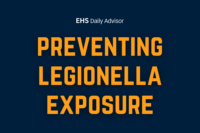No safety technology is changing as fast as that employed in PPE. The devices of just a few years ago are now obsolete by replacements that are lighter, easier to use, and more protective. These resources alert you to developments in the field, and equally important, supply training ideas to get your workers to use their PPE, and use it correctly.
Free Special Report: Does Your PPE Program Meet OSHA’s Requirements?
By: Superior Glove, leading safety glove innovator Glove gauge is a commonly used term to classify knit safety gloves. From cotton to nylon to aramids, string knit gloves typically range from 7-gauge to 21-gauge and offer varying degrees of hazard protection. But what is glove gauge and how does it affect glove performance? What is […]
In this installment of EHSDA Shorts, Jennifer Hsu, MPH, CSP Senior Leader in Environmental, Health, and Safety (EHS) | Certified Safety Professional (CSP), shares her thoughts on ordering personal protective equipment (PPE) for women. This clip was taken from a webinar titled “Creating an Inclusive PPE Program: Connected Tech, the Right Fit, and Change Management.” […]
In cases where Legionella hazards can’t be controlled with engineering and administrative controls, personal protective equipment (PPE) may be needed to prevent worker exposures and infections. Here’s what you need to know about how to protect workers against Legionella exposure with PPE.
On episode 202 of EHS On Tap, Cam Mackey, President and CEO of the International Safety Equipment Association, and Ray Chishti, Senior EHS Editor with J.J. Keller, talk about clearing up the confusion about worker head protection.
OSHA provides PPE enforcement guidance (CPL 02-01-050) that outlines its interpretations of its general industry PPE standards (29 Code of Federal Regulations Part 1910, Subpart I) and procedures for enforcing them. Here’s what you need to know about PPE enforcement procedures.
Back to Basics is a weekly feature that highlights important but possibly overlooked information that any EHS professional should know. This week, we examine OSHA’s requirements for personal protective equipment. When engineering controls, administrative controls, and work practices aren’t enough to protect your employees from exposures to a safety or health hazard, you have to provide […]
Head protection for employees is an essential part of workplace safety. Here’s what you need to know about storage of head protection such as safety helmets.
Back to Basics is a weekly feature that highlights important but possibly overlooked information that any EHS professional should know. This week, we examine guidance on head protection. It’s no revelation that workplace head injuries are a major safety concern. Are you providing the proper head protection for your employees? The hard hat has been […]
Although molds are an important part of the environment, their growth indoors can wreak havoc and cause serious issues. And these problems happen fast. Unforeseen incidents like pipe leaks, and natural disasters like floods, can create standing water, which enables mold to grow in as little as 24 to 48 hours. Because of its rapid […]
On episode 188 of EHS On Tap, Beemal Vasani, head of commercial strategy and business development at Ansell, talks about the growth of wearables and connected PPE.










